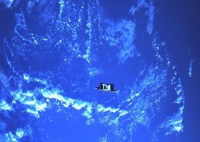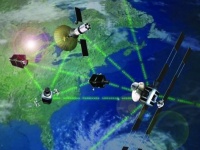
For scientists, this is of huge interest for the discovery of planetary and solar bursts in other solar systems and obtaining a tomographic view of space weather.
Gomes predicts that formation-flying satellites could also be important in space warfare. ’When your enemy is trying to interfere with your equipment, if you have distributed systems it becomes much more difficult. You can also leave your system operating in a loose formation and only bring it together when it’s needed. That reduces the perceived threat the enemy will not realise what the distributed system is until it’s formed and operating.’
“When your enemy is trying to interfere with your equipment, if you have distributed systems it becomes much more difficult”
One issue with developing formation-flying satellites is the power required to maintain formation. Dr Mini Saaj at the Surrey Space Centre is looking at the use of hybrid electric propulsion systems to help solve this problem. The system would scavenge electromagnetic power from drifting space plasma or the Earth’s magnetosphere to maintain position and reduce on-board power requirements. ’I’m also interested in how swarms can be shaped into formations while avoiding collisions,’ she said. ’Techniques borrowed from terrestrial robotics, such as artificial potential fields, could help steer the system.’ Like the OLFAR project, this approach would look to the natural world to animal swarms and herds using shared rules to direct flexible group behaviour.

While these long-term projects may make swarms seem like an exciting proposal, Gomes is less enthusiastic. ’I’m not a fan of close formation flying, especially when it comes to swarms,’ he said. ’There is a guy at NASA whose opinion of swarms is that they are just debris. He has a point. Imagine you have 14 nano-satellites in constellation. If one of those fails, it could knock out several others, if not the entire constellation, causing a cascade of destruction and debris.’ However, Alberto Tobias, head of ESA’s systems, software and technology department, does not believe this would be a problem as long as adequate control systems are in place. He said: ’Intrinsically, formation-flying satellites do not create debris as they have actuation technologies, so they can be controlled.’
Scientists have proposed limiting the flight of swarms to orbital altitudes to reduce risk. Gomes agrees this could be a good solution, and added that the most exciting application for swarms lies in the exploration of unknown environments out of Earth’s orbit. With the emphasis in Europe moving away from human space exploration, satellite swarms could be the future. Whether the technology helps us to understand our universe, or merely ends up as space debris, remains to be seen.
In Depth
DARPA’s programme takes a modular approach
The F6 project run by the US Defense Advanced Research Projects Agency (DARPA) aims to form a virtual satellite by using clusters of what it calls ’fractionated space modules’. Each module is expected to have a unique capability, such as navigation, payload and data handling, and can either be physically connected in orbit, or linked together through a wireless network.
According to DARPA, because the various functions of a spacecraft are developed and launched separately, the overall programme risk will be reduced, budgetary and planning flexibility will be increased and the initial speed of deployment can be improved. The organisation is hoping for a planned flight demonstration of the F6 programme sometime in 2013-14.




Glasgow trial explores AR cues for autonomous road safety
They've ploughed into a few vulnerable road users in the past. Making that less likely will make it spectacularly easy to stop the traffic for...